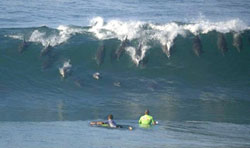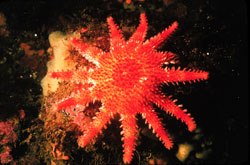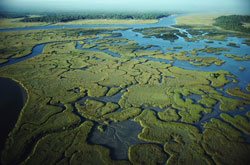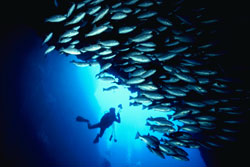You are here: Home › Ecosystems
Ecosystems
An Ecosystem can be defined as the dynamic and interrelating complex of plant and animal communities and their associated non-living environment. Coastal ecosystems are those found from coastal watersheds to the outer boundary of the U.S. 200 mile Exclusive Economic Zone (EEZ). These ecosystems include coastal estuaries (including the subset of National Estuarine Research Reserves), coastal areas under protected under the National Marine Sanctuaries, and coral reef ecosystems. CSCOR sponsors research across all of these coastal ecosystems.
Coastal Oceans
 The
coastal ocean encompasses a broad range of saltwater ecosystems, including
estuaries, coral reefs, rocky shores, gravel shores, sandy shores, mud flats,
marshes and mangrove forests. These ecosystems exist where streams and rivers
meet the sea and where tides and coastal currents mix. With its portfolio of
research programs, Climate Change, Coral
Reefs, Ecological Forecasting, Harmful Algal Blooms, Impacts of Land Use, and Hypoxia and Nutrient Pollution, CSCOR
is at the forefront of NOAA’s effort to understand the structure and
processes that define U.S. coastal oceans. More
The
coastal ocean encompasses a broad range of saltwater ecosystems, including
estuaries, coral reefs, rocky shores, gravel shores, sandy shores, mud flats,
marshes and mangrove forests. These ecosystems exist where streams and rivers
meet the sea and where tides and coastal currents mix. With its portfolio of
research programs, Climate Change, Coral
Reefs, Ecological Forecasting, Harmful Algal Blooms, Impacts of Land Use, and Hypoxia and Nutrient Pollution, CSCOR
is at the forefront of NOAA’s effort to understand the structure and
processes that define U.S. coastal oceans. More
Coral Reefs
 U.S.
coral reef ecosystems are complex resources that contribute to biological
diversity, fisheries production, coastal protection, tourism, maritime and
cultural heritage, and human sustenance. Coral reef ecosystems are under stress
from both natural events (e.g., hurricanes and tropical storms) and human activities
(e.g., tourism, fishing, and dredging). Symptoms such as decreases in hard
coral covers, proliferation of algae, increases in coral bleaching, and disease
outbreaks indicate that almost 60% of the world’s reefs and the resources
they support are at risk. Through its Coral
Reefs programs, CSCOR is
working to reverse the degradation of U.S. coral reef ecosystems. More
U.S.
coral reef ecosystems are complex resources that contribute to biological
diversity, fisheries production, coastal protection, tourism, maritime and
cultural heritage, and human sustenance. Coral reef ecosystems are under stress
from both natural events (e.g., hurricanes and tropical storms) and human activities
(e.g., tourism, fishing, and dredging). Symptoms such as decreases in hard
coral covers, proliferation of algae, increases in coral bleaching, and disease
outbreaks indicate that almost 60% of the world’s reefs and the resources
they support are at risk. Through its Coral
Reefs programs, CSCOR is
working to reverse the degradation of U.S. coral reef ecosystems. More
Estuaries
 Estuaries make up approximately 10,900,000 hectares of the coastline of the
U.S. An estuary is a semi-enclosed coastal body of water that has a measurable
salinity gradient from its freshwater drainage to its ocean entrance. Bay and
estuarine systems are among the most productive ecosystems on earth; however,
for a variety of different reasons, many estuarine systems are experiencing
a decline in productivity. CSCOR,
through its Climate Change, Impacts of Land Use, Harmful Algal Blooms,
and Hypoxia and Nutrient Pollution programs is helping understand the factors involved in any decline of the nation’s estuaries and develop methodologies for restoring estuarine habitats. More
Estuaries make up approximately 10,900,000 hectares of the coastline of the
U.S. An estuary is a semi-enclosed coastal body of water that has a measurable
salinity gradient from its freshwater drainage to its ocean entrance. Bay and
estuarine systems are among the most productive ecosystems on earth; however,
for a variety of different reasons, many estuarine systems are experiencing
a decline in productivity. CSCOR,
through its Climate Change, Impacts of Land Use, Harmful Algal Blooms,
and Hypoxia and Nutrient Pollution programs is helping understand the factors involved in any decline of the nation’s estuaries and develop methodologies for restoring estuarine habitats. More
National Marine Sanctuaries
 National marine sanctuaries (NMS) are areas that have been set aside
for maintaining the integrity of their unique natural and cultural
resources. They include everything from the breeding and feeding grounds
of marine animals, to significant coral reefs, kelp forest habitats,
and the remains of a sunken historic Civil War ironclad. Currently
there are 13 NMS, found in both the Pacific and Atlantic Oceans, off
the coast of American Samoa, and in the Great Lakes. NCCOS is partnering
with the National Marine Sanctuary Program to determine their overall status, achieve their preservation objectives, and examine the alternative management actions on sanctuary ecosystems. CSCOR-sponsored scientists, through the Impacts of Land Use, South Florida Ecosystems and Harmful Algal Blooms programs, work closely with staff at different national marine sanctuaries to improve our understanding of sanctuary ecosystems.
More
National marine sanctuaries (NMS) are areas that have been set aside
for maintaining the integrity of their unique natural and cultural
resources. They include everything from the breeding and feeding grounds
of marine animals, to significant coral reefs, kelp forest habitats,
and the remains of a sunken historic Civil War ironclad. Currently
there are 13 NMS, found in both the Pacific and Atlantic Oceans, off
the coast of American Samoa, and in the Great Lakes. NCCOS is partnering
with the National Marine Sanctuary Program to determine their overall status, achieve their preservation objectives, and examine the alternative management actions on sanctuary ecosystems. CSCOR-sponsored scientists, through the Impacts of Land Use, South Florida Ecosystems and Harmful Algal Blooms programs, work closely with staff at different national marine sanctuaries to improve our understanding of sanctuary ecosystems.
More

